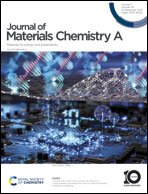Mitigating phosphoric acid migration in high temperature polymer electrolyte membrane fuel cells with hydrophobic polysilsesquioxane-based binders†
Abstract
Cross-linkable organosilsesquioxanes were synthesized for application as catalyst binders in high temperature polymer electrolyte membrane fuel cells (HT-PEMFCs). Four different organic functional groups were examined including methyl, phenyl, fluoroalkyl, and fluorophenyl and their chemical, physical, surface, and electrochemical properties were characterized. The effect of surface hydrophobicity on a HT-PEMFC membrane electrode assembly was elucidated, showing that organosilsesquioxanes with lower surface tension or higher hydrophobicity towards water and phosphoric acid could be considered as a key parameter for HT-PEMFC performance. Fuel cell tests showed that the pentafluorophenyl-functionalized organosilsesquioxane showed improved H2/air performance (a peak power density of 527 mW cm−2 at 0.4 V) compared to the MEA with PTFE (a peak power density of 425 mW cm−2 at 0.4 V). Short term durability tests for 500 h showed that membrane electrode assemblies with alternative binders were stable and the developed organosilsesquioxane binders are a viable alternative to PTFE-based binders, all the while having additional advantages in vastly simplified ink slurry preparation through increased dispersibility in alcohol–water mixtures.



 Please wait while we load your content...
Please wait while we load your content...